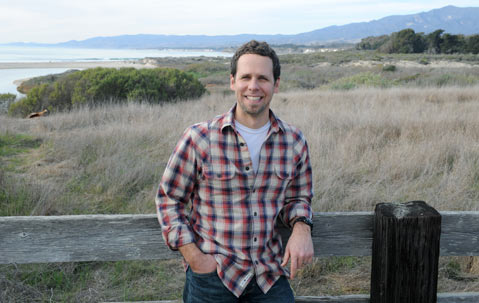40 Years of Protecting Rare Critters
UCSB Professor Peter Alagona's Book Examines Four Decades of the Endangered Species Act

On December 28, 2013, the Endangered Species Act (ESA) turned 40 years old, and contemporary supporters of the bipartisan measure signed by President Richard Nixon in 1973 credit the law with recovering 31 species from the brink of extinction and further protecting another 2,000-plus or so plants and animals from what may have been utter doom. But what seemed like a great idea 40 years ago has also turned into one of the country’s most divisive pieces of legislation, quite often pitting landowners and business interests against the will of environmentalists and the public at large — and sometimes pitting environmentalists against that very same public when protecting species comes at the expense of regional economies.
Altogether, the ESA now sits at the core of America’s philo- sophical divide, which — in admittedly simplistic, extreme terms —ponders this question: Do we protect the Earth at all costs with greater resulting hassles for humankind, or do we enable humankind to thrive at every possible turn, at the expense of the Earth and the rest of its inhabitants?
One of the foremost authorities on how this situation came to be is UCSB’s Peter Alagona, an environmental historian who teaches the popular intro class to environmental studies, among other undergrad and upper division courses. Having become fascinated with the plight of endangered species as a kid — and exploring that interest at Northwestern, UCSB, UCLA, Harvard, and Stanford — Alagona has been researching the evolution of the ESA for the better part of a decade. In May 2013, he published his first book, After the Grizzly: Endangered Species and the Politics of Place in California, focusing on the individual sagas of the Delta smelt, desert tortoise, San Joaquin kit fox, and California condor to evaluate the successes and failures of the ESA, 40 years in.
Though Alagona’s book examines the myriad and complicated issues in depth, his conclusion is crystal clear: “The take-home message is that the Endangered Species Act has done a really good job of preventing extinctions, but it’s done a really poor job pro- moting the recovery of species that are on the list.” He answered a lot more of my questions during a couple of conversations last year, and what follows is an edited version of our talks.

So it’s the 40th anniversary of the Endangered Species Act. How’s it going? The ESA has definitely done a lot of good, but overall, the results to date are mixed. Of the around 1,500 species that have ever been listed as“endangered”in the United States,less than 2 percent have been removed from the list because they were recovered, but less than one percent have been removed from the list because they went extinct. So if the ESA is doing pretty well at preventing extinction and poorly at promoting recoveries, the question is: How can we actually recover more species instead of having them in a permanent purgatory?
You don’t think that the popular practice of preserving habitat always works? On a very basic level, it’s true: If there is no habitat, there can be no wild members of a species. But the logic then becomes,“Let’s just draw lines on a map, set areas aside, and hopefully that will solve all of our problems.” The truth is that it is much more complicated than that.Although preserving habitat has done a lot of good, it’s not the panacea that it’s often promoted as.
One example is in the Mojave Desert, where we created wil- derness for the desert tortoise. The idea was that if we just back off, we’ll be able to save the species. But the desert has been transformed and beat up and is undergoing so much pressure that even the large areas we set aside are failing to maintain the tortoise populations that once lived there. So how can we think of habitat in different ways in order to promote recovery for the species that live there?
Given the red-hot politics that surround endangered species, there must be risk to admit habitat conservation isn’t working. No one wants to admit that a program they initiated isn’t working, and we do need a lot more habitat conservation in the old way of setting land aside, but there is no amount of land that you could do that would be enough. We shouldn’t turn all of our wilderness over to the mining companies, but we need to think of conservation as involving the entire landscape, including places where people live and work—not just parks you visit once a year. Aldo Leopold used to think about this idea of how to better conserve or improve habitats that are close to where we produce commodities. We need more of that, not less protected areas.
But that could mean changing the priorities of some of these groups. Some are already doing it, like the Nature Conservancy, but they’ve gotten some flack for using graz- ing as a grassland management tool. But that could keep weeds at bay and restore native grasses. This requires a little reorientation toward thinking of habitat not just as how we want to see it, which is often as parks and preserves, but thinking of habitat in the way that these species see it, which is resources to be used.
Where do private landowners fit into the mix? When I go around and talk to farmers and ranchers, which I do a lot, they see themselves as land managers, and they say that they really love wildlife and always have and that they consider themselves conservationists. But there needs to be a balance for them. If you actually gave them clear incentives, like money or tax breaks, they would manage their land for conservation because they respond to the market. And they will be happy to, because they like the wildlife.
One criticism that economists have of the ESA is that the benefits of species conservation accrue to society but the costs are borne by a relatively small population of individuals. So let’s have the political will to meet that head-on, to incentivize the kinds of actions that people in society say they want. It’s a matter of putting your money where your mouth is.
I don’t have a lot of faith in that happening anytime soon, at least from Washington. But at the state level, these things can work.
Where does Santa Barbara fit into the endangered-species picture? Santa Barbara is at the heart of this, but it is really a Southern California thing. From Santa Barbara to the Mexican border is really the country’s hot spot for biodiversity. There are so many endemic species and so many different kinds of landscapes and so much growth and so many people. Southern California is really ground zero for the whole endangered-species issue, the place where a lot of policy innovations have been developed.
You argue that these innovations are really key to recov- ering more species but that the law makes it tough to try them out. At the time the ESA was created, it was geared toward transparency and deliberate procedures for decision-making. It’s good at that, but what it doesn’t do very well is provide for experimentation and flexibility. Those two things, flexibility and stepwise, transparent decision-making, are kind of hard to gel. That’s a real challenge.
But we could improve the ESA to promote more learning- by-doing, more of what conservation biologists call “adaptive management.” You develop a hypothesis, and then you try it out. You don’t do it willy-nilly, because you don’t want to drive the species to extinction in the process, but you do it, and that guides your next hypothesis. It could be used without jeopardiz- ing populations.
4·1·1
Peter Alagona will discuss his research on the Endangered Species Act as part of the Culture and Nature series at the Santa Barbara Museum of Natural History on February 6 at 7 p.m. See peteralagona.com



